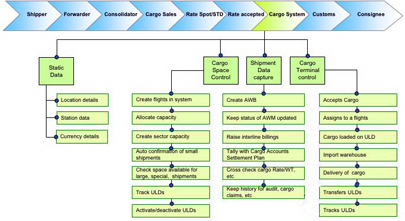RFID adoption in the airline industry has lagged behind retail and other sectors. In the airline industry, RFID could potentially be used to track unit load devices (ULDs) and other ground-handling equipment, as well as time-definite (TD) cargo shipments, passenger baggage and spare aircraft parts. An automated RFID-based tracking solution could not only address most of the prevalent problems airlines face in ULD management, but also emerge as the inflection point for RFID’s adoption in that industry, leading to its wider usage in more applications.
Airlines need to cut cargo operational costs by efficient utilization of all ground cargo-handling assets, particularly the ULDs, aluminum pallets or containers they use. Pallets are utilized to stack air cargo shipments, while containers are used for loading baggage aboard an aircraft. One endemic problem airlines face—and one that directly impacts carriage capacity—is poor ULD tracking. Considerable working airline capital is deployed maintaining a rolling stock of ULDs.
(Click here for a larger version of the photo.)
Making A Business Case Based on ROI
RFID-tagging of ULDs or cargo shipments would entail the installation of interrogators and other RFID infrastructures at all major airports throughout the world, as well as hosting information database systems to make data available to all airlines for widespread adoption. There would be a need for huge investments to enact a global rollout, and no single airline can afford to go ahead alone. A global rollout would need to establish a clear road map, along with an unambiguous business case based on such time-tested methods for return on investment (ROI) as payback, net present value (NPV) and the internal rate of return (IRR).
ROI math for business case is based on the following information:
- Historical data on yearly losses of ULDs and utilization rates over their productive life, in hours per year.
- The replacement costs or book value of lost ULDs.
- The cost of stock-outs (not having enough ULDs when needed), or the expense of delay.
- The cost of carrying additional ULD inventory.
- The cost of initial investments in RFID infrastructure, tags and so forth.
(Click here for a larger version of the photo.)
The key decisions for the airline industry are as follow:
- Selecting the type of RFID tags, such as UHF passive, active or Wi-Fi active, after technological performance in real-life pilots.
- Singling out the pallets used in air cargo for RFID tracking, and keeping out the other 50 percent of ULDs—namely the containers used for loading baggage. Baggage containers are rarely lost or misplaced by airlines, so limiting tracking to only pallets could substantially reduce RFID infrastructure costs, tag costs and so on.
- Standardizing cargo-handling procedures at major airports, which could possibly reduce the number of reader locations from six positions to three, thus leading to large cost savings.
- Apportioning the costs of a global RFID tracking rollout to airlines based on usage, to make the application service provider (ASP) model work on a 24/7 basis, at a low cost.
- Creating innovative pricing models recommending additional charges for airports or ground handling agents (GHAs) looking to recover their capital investments in RFID technology
The IATA taking a lead role in creating a common industry standard for RFID solutions
Optimizing investments made in establishing an RFID infrastructure to track time-definite shipments, after-market aircraft spares, passenger baggage and so forth (Phase II).
At Infosys, we believe RFID technology offers a better business case for tracking ULDs. However, decisions regarding the selection of RFID technology (passive or active tags), tag databases, industry-standard numbering logic across different locations, agreement on tag location, readers and hosting ASP solutions across major airports must be made only after careful analysis, backed by results from real-life pilots.
The tradeoff between the type and cost of tags, the number of reader locations, the accuracy of read rates, distances, interferences, noise, global compatibility standards on data sharing, battery life, vendor management for procuring tags and the value perceived by airlines’ needs (vis-à-vis the capital costs) must be carefully analyzed. An RFID ULD-tracking solution could also help the airline industry standardize handling processes in air cargo. To further optimize their RFID infrastructure investment in tracking ULDs, airlines could also use the system to track premium, time-definite express cargo across their networks, comply with new FAA security regulations and more.
Pankaj Narayan Pandit, a principal consultant, for airlines practice with Infosys Technologies, has over 16 years of experience in the airline industry.



